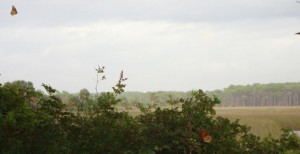Magnificent Monarchs on St Mark’s
by Karen
As I go about the business of putting a life back together, there’s nothing I’d like more than an escape to the sandy beaches of my youth. I look forward to the point when I will have enough settled to feel like I can responsibly be away for a little while. The shore is where I feel most at home, but these days “You can’t go home again” has extra meaning. Not in the sense that the physical house that was my home is gone, but more in the sense that the place that is my other home, the place where a part of me belongs, has changed. It’s not just that the barefoot casual place that was wild and accessible when I was young has been overrun with highrises and upscale brand names. It’s also that now, when I walk down the beach, there will be some point when a little hint of discomfort makes me wonder about the effects of BP dispersants, EPA waivers on paper company scrubbers and Monsanto. What persistent heavy duty chemicals am I grinding into my heels to be absorbed through my skin?
I came across this un-posted entry while going through the inner workings of my blog and getting ready to write and post on a rigorous schedule. In some ways it may seem like I’m not on target for the “new” face of my old blog, but this little piece of heaven that I first wrote about three years ago is exactly the point, so here is my updated post.
We were heading away from the Okefenokee NWR toward St. Josephs Peninsula in a leisurely “see things along the way” path when we pulled into St Mark’s NWR. We arrived as the Visitor’s Center was closing. As the ranger was walking down the ramp Russ asked “What’s the one thing we need to know?” She attempted to narrow our interests and then told us about the current state of a few different animals. She said “I don’t know if the Monarchs are still down there. I haven’t been down today.”
I missed seeing the Monarchs en masse at the end of their migration in Mexico on a visit to Leon a few years back. A case of Montezuma’s revenge kept me from heading for the hinterlands, so this was a pleasant surprise. We headed toward the lighthouse, slowing for deer and stopping to see a few birding sights along the way. I let out a little gasp when we drove by a bush covered in Monarchs. Russ didn’t see it. When he heard me he thought there was a traffic hazard.
We made it (accident free) to the light house and there they were by the hundreds. They were spread about, near and far, but no other bushes covered with the density of the first one I had seen on Lighthouse Rd. They were flying in groups, almost swarming. They were in pairs sometimes swirling around one another. At times it looked like a mating dance. We wandered around for a few minutes taking photos and the sun sank in the sky, none quite captured the experience. It wasn’t my dream of seeing them densely packed by the hectare in Mexico, but it was a little piece of the dream and because it was unexpected. There was nothing real or imagined for it to live up to, just an unexpected afternoon joy.
Monarchs migrate to and from all over North and Central America. A local event that celebrates the Monarch butterfly happens annually in July at the Chattahoochee Nature Center. The festival delights children as well as adults. It is filled with creativity, learning and celebration. There are butterfly releases, face painting and a journey through the woods that illustrates the journey of the Monarchs, last time I went there was a native plant sale in conjunction with the festival, and it was truly one of the best events for engaging children that I have attended.
Here is a link from the World Wildlife Federation here here is a tracking site and here is an article from The Economist. I’d be cautious about how that advice in The Economist is characterized though. If you share my dream to see these magnificent insects at their densest, “stampede” isn’t the way to go about things. Tourist money may well stop illegal logging, but large numbers of tourists without care can “love them to death” with as much damage as loggers do.
The only thing more wonderful than seeing this natural spectacle, would be the pleasure of taking my children and grandchildren, something that seems more at risk in the last year. This year was again a year when migration numbers have been disturbingly lower than any previously recorded lows. It has also become a political ploy, showing up in divisive “shame on you” advertising, messages and memes that tend to overwhelm, un-inform and shut down everyone and everything positive or progressive, bringing the miracle into the realm where vocabulary is loaded, real thought is suspended and nothing is sacred.
The truth though is that it is sacred, no matter how some would politify and deface it. That which is natural and beautiful is sacred, above and beyond whether or not it is recognized as such. Another truth is that we get to live in the world we create and so do our great grandchildren. So give the power to your faith and your habits rather than your pundits. Our decisions count. From the decision to re-use items rather than letting them go to the landfill all the way to the decision to step on the podium and offer up an alternative. It is all connected and it all matters.


